Cultural Diversity: Reflecting on Identity and Social Work Practice
VerifiedAdded on 2023/04/11
|9
|2480
|393
Essay
AI Summary
This essay explores cultural diversity through the lens of a Bangladeshi international student in Australia. It delves into the student's cultural origins, beliefs, and values, contrasting them with Australian norms. The essay documents experiences of racial discrimination, prejudice, and cultural dominance encountered during the student's initial days in Australia, analyzing the influence of these experiences on their identity and future career aspirations. It also reflects on the complexities of multiculturalism in both Bangladesh and Australia, highlighting the importance of individual attitudes over generalizing about entire cultures. The essay concludes with a consideration of how these experiences might shape the student's approach to social work practice, particularly in relation to diverse client populations.
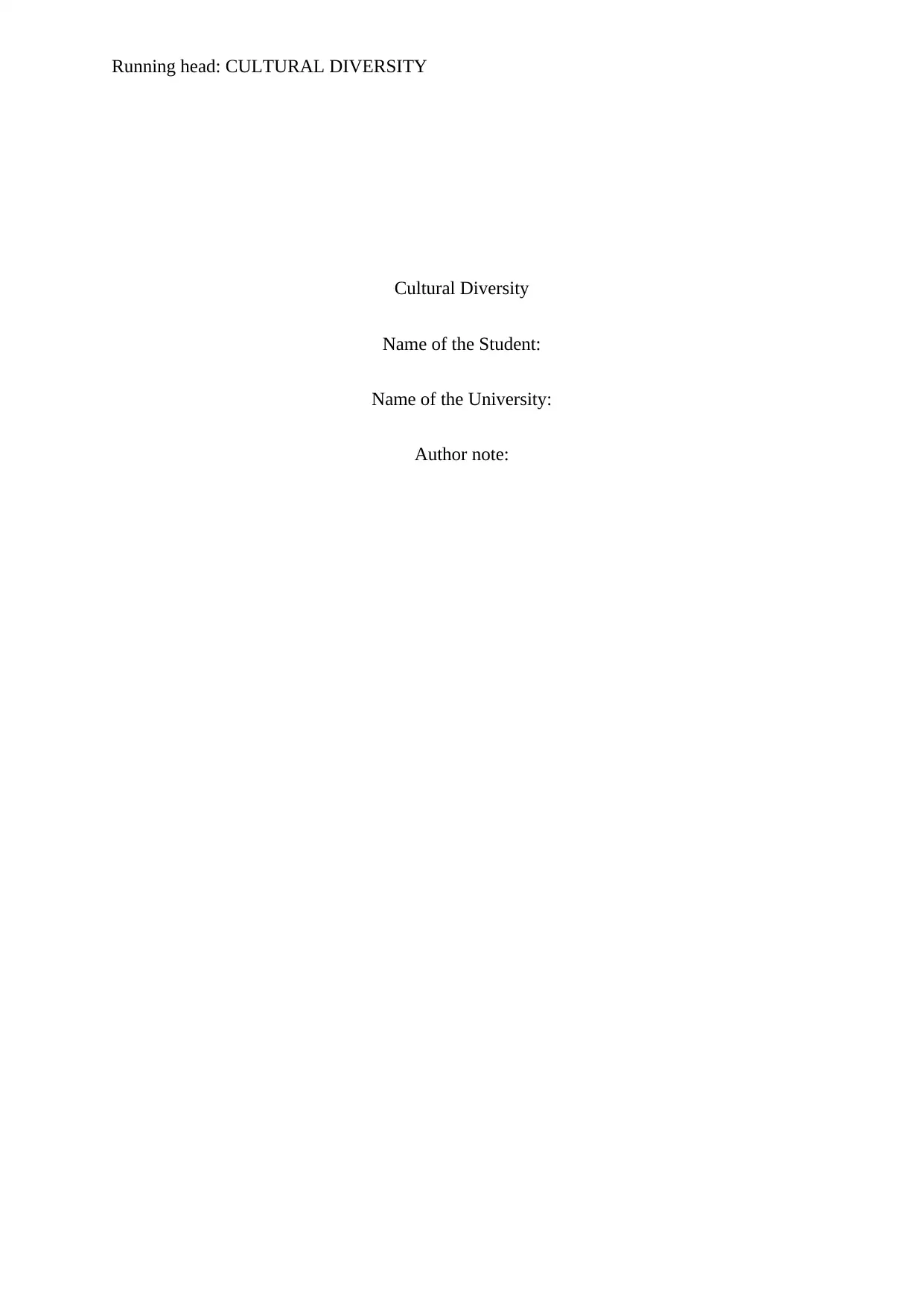
Running head: CULTURAL DIVERSITY
Cultural Diversity
Name of the Student:
Name of the University:
Author note:
Cultural Diversity
Name of the Student:
Name of the University:
Author note:
Paraphrase This Document
Need a fresh take? Get an instant paraphrase of this document with our AI Paraphraser
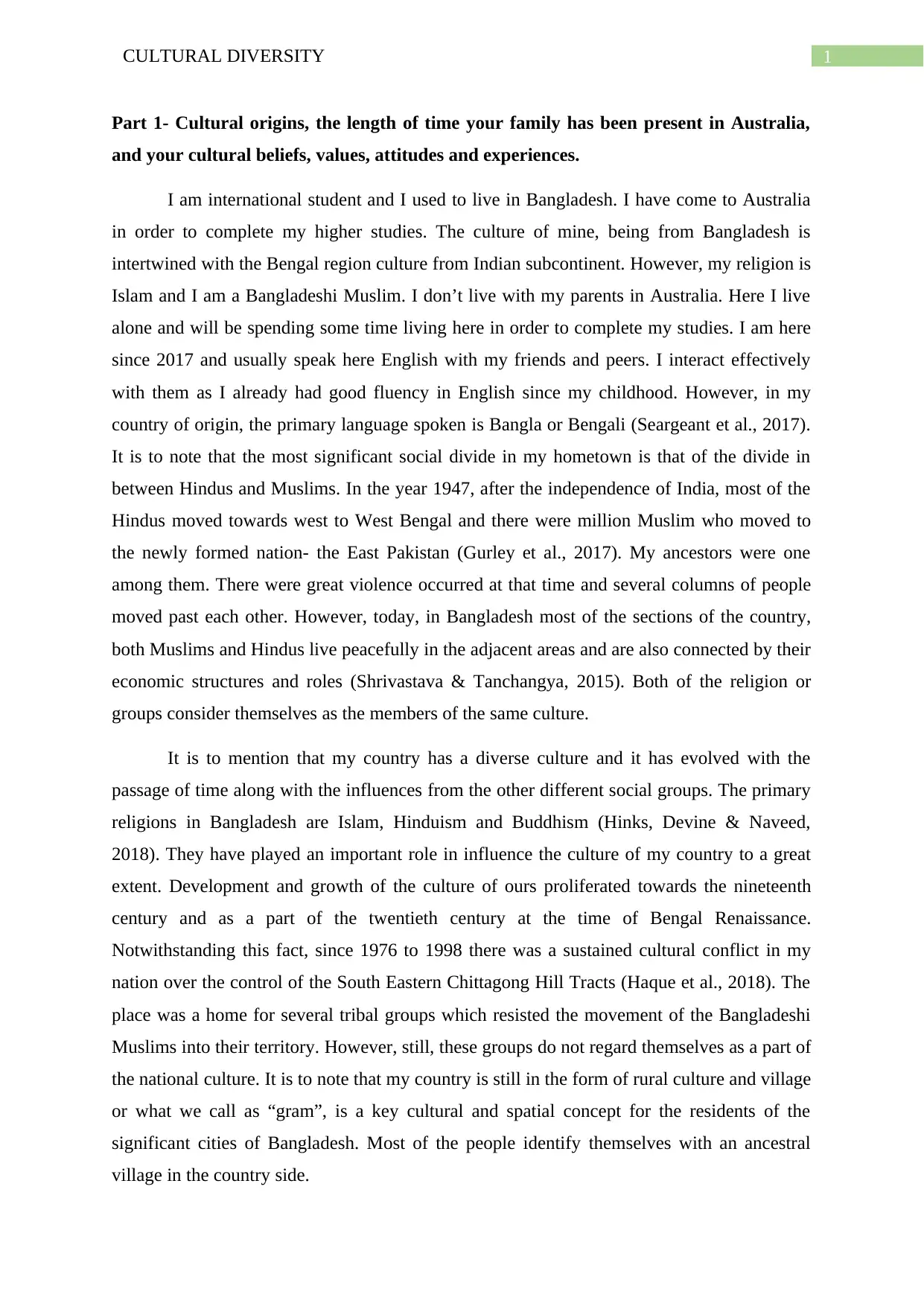
1CULTURAL DIVERSITY
Part 1- Cultural origins, the length of time your family has been present in Australia,
and your cultural beliefs, values, attitudes and experiences.
I am international student and I used to live in Bangladesh. I have come to Australia
in order to complete my higher studies. The culture of mine, being from Bangladesh is
intertwined with the Bengal region culture from Indian subcontinent. However, my religion is
Islam and I am a Bangladeshi Muslim. I don’t live with my parents in Australia. Here I live
alone and will be spending some time living here in order to complete my studies. I am here
since 2017 and usually speak here English with my friends and peers. I interact effectively
with them as I already had good fluency in English since my childhood. However, in my
country of origin, the primary language spoken is Bangla or Bengali (Seargeant et al., 2017).
It is to note that the most significant social divide in my hometown is that of the divide in
between Hindus and Muslims. In the year 1947, after the independence of India, most of the
Hindus moved towards west to West Bengal and there were million Muslim who moved to
the newly formed nation- the East Pakistan (Gurley et al., 2017). My ancestors were one
among them. There were great violence occurred at that time and several columns of people
moved past each other. However, today, in Bangladesh most of the sections of the country,
both Muslims and Hindus live peacefully in the adjacent areas and are also connected by their
economic structures and roles (Shrivastava & Tanchangya, 2015). Both of the religion or
groups consider themselves as the members of the same culture.
It is to mention that my country has a diverse culture and it has evolved with the
passage of time along with the influences from the other different social groups. The primary
religions in Bangladesh are Islam, Hinduism and Buddhism (Hinks, Devine & Naveed,
2018). They have played an important role in influence the culture of my country to a great
extent. Development and growth of the culture of ours proliferated towards the nineteenth
century and as a part of the twentieth century at the time of Bengal Renaissance.
Notwithstanding this fact, since 1976 to 1998 there was a sustained cultural conflict in my
nation over the control of the South Eastern Chittagong Hill Tracts (Haque et al., 2018). The
place was a home for several tribal groups which resisted the movement of the Bangladeshi
Muslims into their territory. However, still, these groups do not regard themselves as a part of
the national culture. It is to note that my country is still in the form of rural culture and village
or what we call as “gram”, is a key cultural and spatial concept for the residents of the
significant cities of Bangladesh. Most of the people identify themselves with an ancestral
village in the country side.
Part 1- Cultural origins, the length of time your family has been present in Australia,
and your cultural beliefs, values, attitudes and experiences.
I am international student and I used to live in Bangladesh. I have come to Australia
in order to complete my higher studies. The culture of mine, being from Bangladesh is
intertwined with the Bengal region culture from Indian subcontinent. However, my religion is
Islam and I am a Bangladeshi Muslim. I don’t live with my parents in Australia. Here I live
alone and will be spending some time living here in order to complete my studies. I am here
since 2017 and usually speak here English with my friends and peers. I interact effectively
with them as I already had good fluency in English since my childhood. However, in my
country of origin, the primary language spoken is Bangla or Bengali (Seargeant et al., 2017).
It is to note that the most significant social divide in my hometown is that of the divide in
between Hindus and Muslims. In the year 1947, after the independence of India, most of the
Hindus moved towards west to West Bengal and there were million Muslim who moved to
the newly formed nation- the East Pakistan (Gurley et al., 2017). My ancestors were one
among them. There were great violence occurred at that time and several columns of people
moved past each other. However, today, in Bangladesh most of the sections of the country,
both Muslims and Hindus live peacefully in the adjacent areas and are also connected by their
economic structures and roles (Shrivastava & Tanchangya, 2015). Both of the religion or
groups consider themselves as the members of the same culture.
It is to mention that my country has a diverse culture and it has evolved with the
passage of time along with the influences from the other different social groups. The primary
religions in Bangladesh are Islam, Hinduism and Buddhism (Hinks, Devine & Naveed,
2018). They have played an important role in influence the culture of my country to a great
extent. Development and growth of the culture of ours proliferated towards the nineteenth
century and as a part of the twentieth century at the time of Bengal Renaissance.
Notwithstanding this fact, since 1976 to 1998 there was a sustained cultural conflict in my
nation over the control of the South Eastern Chittagong Hill Tracts (Haque et al., 2018). The
place was a home for several tribal groups which resisted the movement of the Bangladeshi
Muslims into their territory. However, still, these groups do not regard themselves as a part of
the national culture. It is to note that my country is still in the form of rural culture and village
or what we call as “gram”, is a key cultural and spatial concept for the residents of the
significant cities of Bangladesh. Most of the people identify themselves with an ancestral
village in the country side.
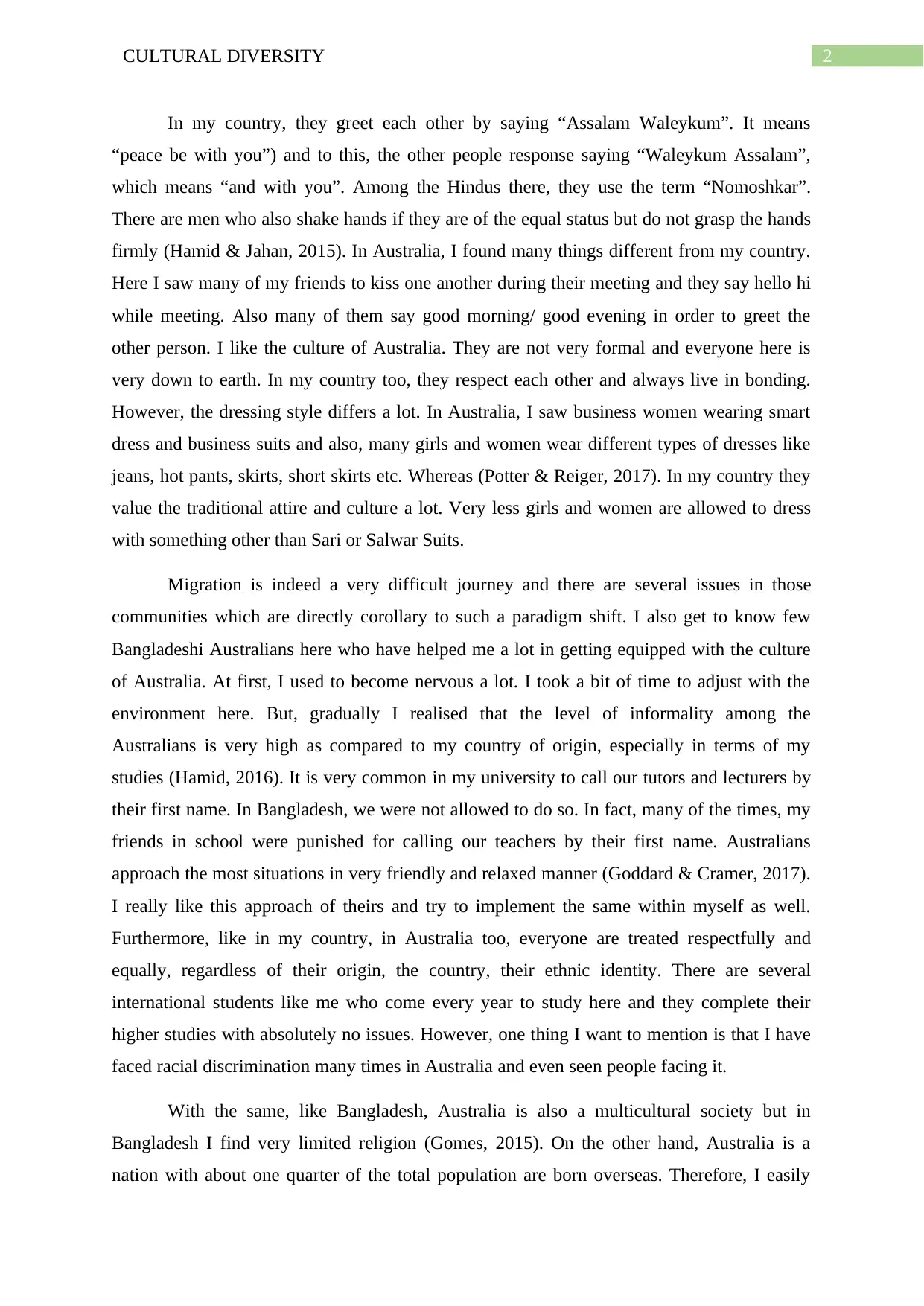
2CULTURAL DIVERSITY
In my country, they greet each other by saying “Assalam Waleykum”. It means
“peace be with you”) and to this, the other people response saying “Waleykum Assalam”,
which means “and with you”. Among the Hindus there, they use the term “Nomoshkar”.
There are men who also shake hands if they are of the equal status but do not grasp the hands
firmly (Hamid & Jahan, 2015). In Australia, I found many things different from my country.
Here I saw many of my friends to kiss one another during their meeting and they say hello hi
while meeting. Also many of them say good morning/ good evening in order to greet the
other person. I like the culture of Australia. They are not very formal and everyone here is
very down to earth. In my country too, they respect each other and always live in bonding.
However, the dressing style differs a lot. In Australia, I saw business women wearing smart
dress and business suits and also, many girls and women wear different types of dresses like
jeans, hot pants, skirts, short skirts etc. Whereas (Potter & Reiger, 2017). In my country they
value the traditional attire and culture a lot. Very less girls and women are allowed to dress
with something other than Sari or Salwar Suits.
Migration is indeed a very difficult journey and there are several issues in those
communities which are directly corollary to such a paradigm shift. I also get to know few
Bangladeshi Australians here who have helped me a lot in getting equipped with the culture
of Australia. At first, I used to become nervous a lot. I took a bit of time to adjust with the
environment here. But, gradually I realised that the level of informality among the
Australians is very high as compared to my country of origin, especially in terms of my
studies (Hamid, 2016). It is very common in my university to call our tutors and lecturers by
their first name. In Bangladesh, we were not allowed to do so. In fact, many of the times, my
friends in school were punished for calling our teachers by their first name. Australians
approach the most situations in very friendly and relaxed manner (Goddard & Cramer, 2017).
I really like this approach of theirs and try to implement the same within myself as well.
Furthermore, like in my country, in Australia too, everyone are treated respectfully and
equally, regardless of their origin, the country, their ethnic identity. There are several
international students like me who come every year to study here and they complete their
higher studies with absolutely no issues. However, one thing I want to mention is that I have
faced racial discrimination many times in Australia and even seen people facing it.
With the same, like Bangladesh, Australia is also a multicultural society but in
Bangladesh I find very limited religion (Gomes, 2015). On the other hand, Australia is a
nation with about one quarter of the total population are born overseas. Therefore, I easily
In my country, they greet each other by saying “Assalam Waleykum”. It means
“peace be with you”) and to this, the other people response saying “Waleykum Assalam”,
which means “and with you”. Among the Hindus there, they use the term “Nomoshkar”.
There are men who also shake hands if they are of the equal status but do not grasp the hands
firmly (Hamid & Jahan, 2015). In Australia, I found many things different from my country.
Here I saw many of my friends to kiss one another during their meeting and they say hello hi
while meeting. Also many of them say good morning/ good evening in order to greet the
other person. I like the culture of Australia. They are not very formal and everyone here is
very down to earth. In my country too, they respect each other and always live in bonding.
However, the dressing style differs a lot. In Australia, I saw business women wearing smart
dress and business suits and also, many girls and women wear different types of dresses like
jeans, hot pants, skirts, short skirts etc. Whereas (Potter & Reiger, 2017). In my country they
value the traditional attire and culture a lot. Very less girls and women are allowed to dress
with something other than Sari or Salwar Suits.
Migration is indeed a very difficult journey and there are several issues in those
communities which are directly corollary to such a paradigm shift. I also get to know few
Bangladeshi Australians here who have helped me a lot in getting equipped with the culture
of Australia. At first, I used to become nervous a lot. I took a bit of time to adjust with the
environment here. But, gradually I realised that the level of informality among the
Australians is very high as compared to my country of origin, especially in terms of my
studies (Hamid, 2016). It is very common in my university to call our tutors and lecturers by
their first name. In Bangladesh, we were not allowed to do so. In fact, many of the times, my
friends in school were punished for calling our teachers by their first name. Australians
approach the most situations in very friendly and relaxed manner (Goddard & Cramer, 2017).
I really like this approach of theirs and try to implement the same within myself as well.
Furthermore, like in my country, in Australia too, everyone are treated respectfully and
equally, regardless of their origin, the country, their ethnic identity. There are several
international students like me who come every year to study here and they complete their
higher studies with absolutely no issues. However, one thing I want to mention is that I have
faced racial discrimination many times in Australia and even seen people facing it.
With the same, like Bangladesh, Australia is also a multicultural society but in
Bangladesh I find very limited religion (Gomes, 2015). On the other hand, Australia is a
nation with about one quarter of the total population are born overseas. Therefore, I easily
⊘ This is a preview!⊘
Do you want full access?
Subscribe today to unlock all pages.

Trusted by 1+ million students worldwide
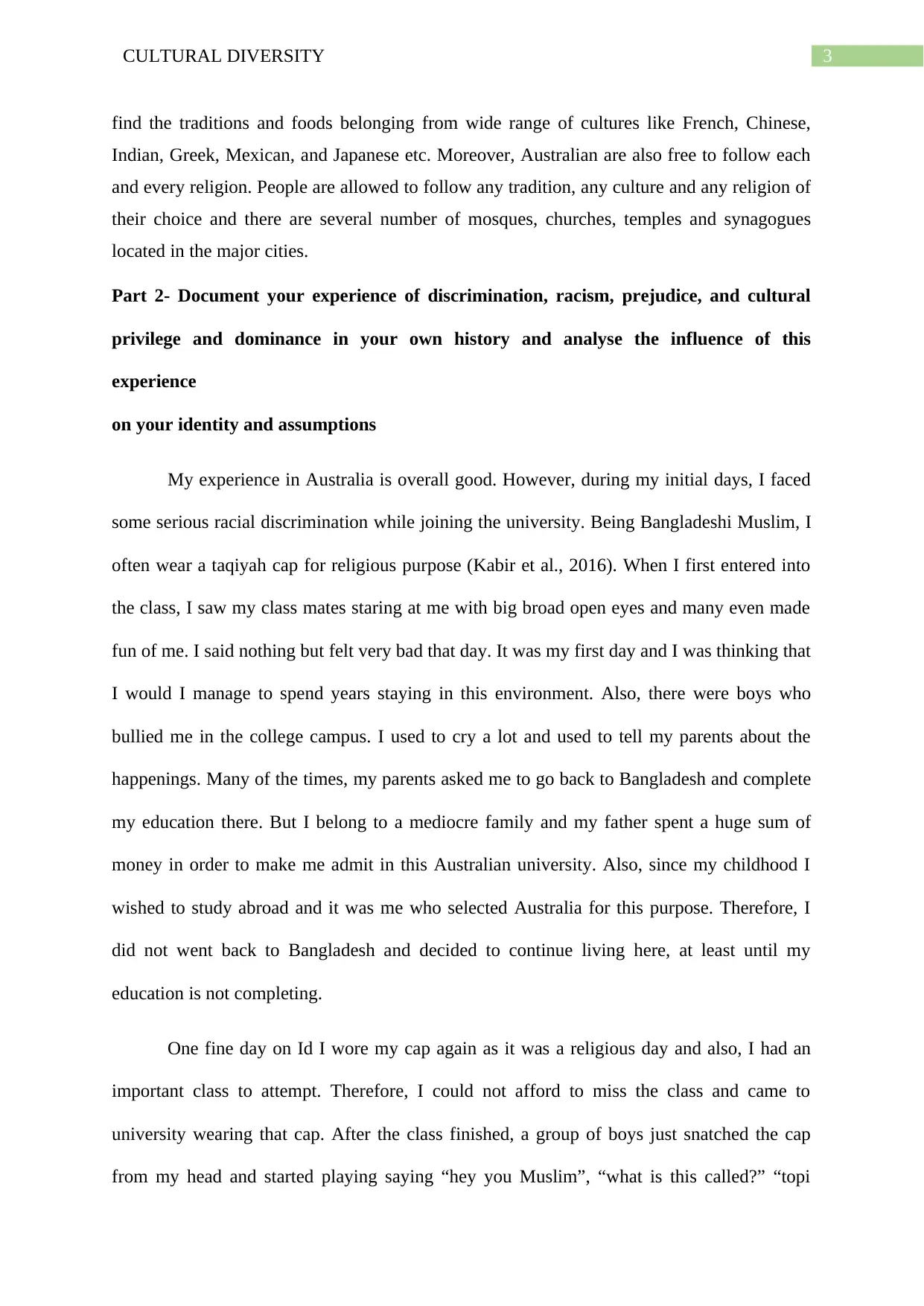
3CULTURAL DIVERSITY
find the traditions and foods belonging from wide range of cultures like French, Chinese,
Indian, Greek, Mexican, and Japanese etc. Moreover, Australian are also free to follow each
and every religion. People are allowed to follow any tradition, any culture and any religion of
their choice and there are several number of mosques, churches, temples and synagogues
located in the major cities.
Part 2- Document your experience of discrimination, racism, prejudice, and cultural
privilege and dominance in your own history and analyse the influence of this
experience
on your identity and assumptions
My experience in Australia is overall good. However, during my initial days, I faced
some serious racial discrimination while joining the university. Being Bangladeshi Muslim, I
often wear a taqiyah cap for religious purpose (Kabir et al., 2016). When I first entered into
the class, I saw my class mates staring at me with big broad open eyes and many even made
fun of me. I said nothing but felt very bad that day. It was my first day and I was thinking that
I would I manage to spend years staying in this environment. Also, there were boys who
bullied me in the college campus. I used to cry a lot and used to tell my parents about the
happenings. Many of the times, my parents asked me to go back to Bangladesh and complete
my education there. But I belong to a mediocre family and my father spent a huge sum of
money in order to make me admit in this Australian university. Also, since my childhood I
wished to study abroad and it was me who selected Australia for this purpose. Therefore, I
did not went back to Bangladesh and decided to continue living here, at least until my
education is not completing.
One fine day on Id I wore my cap again as it was a religious day and also, I had an
important class to attempt. Therefore, I could not afford to miss the class and came to
university wearing that cap. After the class finished, a group of boys just snatched the cap
from my head and started playing saying “hey you Muslim”, “what is this called?” “topi
find the traditions and foods belonging from wide range of cultures like French, Chinese,
Indian, Greek, Mexican, and Japanese etc. Moreover, Australian are also free to follow each
and every religion. People are allowed to follow any tradition, any culture and any religion of
their choice and there are several number of mosques, churches, temples and synagogues
located in the major cities.
Part 2- Document your experience of discrimination, racism, prejudice, and cultural
privilege and dominance in your own history and analyse the influence of this
experience
on your identity and assumptions
My experience in Australia is overall good. However, during my initial days, I faced
some serious racial discrimination while joining the university. Being Bangladeshi Muslim, I
often wear a taqiyah cap for religious purpose (Kabir et al., 2016). When I first entered into
the class, I saw my class mates staring at me with big broad open eyes and many even made
fun of me. I said nothing but felt very bad that day. It was my first day and I was thinking that
I would I manage to spend years staying in this environment. Also, there were boys who
bullied me in the college campus. I used to cry a lot and used to tell my parents about the
happenings. Many of the times, my parents asked me to go back to Bangladesh and complete
my education there. But I belong to a mediocre family and my father spent a huge sum of
money in order to make me admit in this Australian university. Also, since my childhood I
wished to study abroad and it was me who selected Australia for this purpose. Therefore, I
did not went back to Bangladesh and decided to continue living here, at least until my
education is not completing.
One fine day on Id I wore my cap again as it was a religious day and also, I had an
important class to attempt. Therefore, I could not afford to miss the class and came to
university wearing that cap. After the class finished, a group of boys just snatched the cap
from my head and started playing saying “hey you Muslim”, “what is this called?” “topi
Paraphrase This Document
Need a fresh take? Get an instant paraphrase of this document with our AI Paraphraser
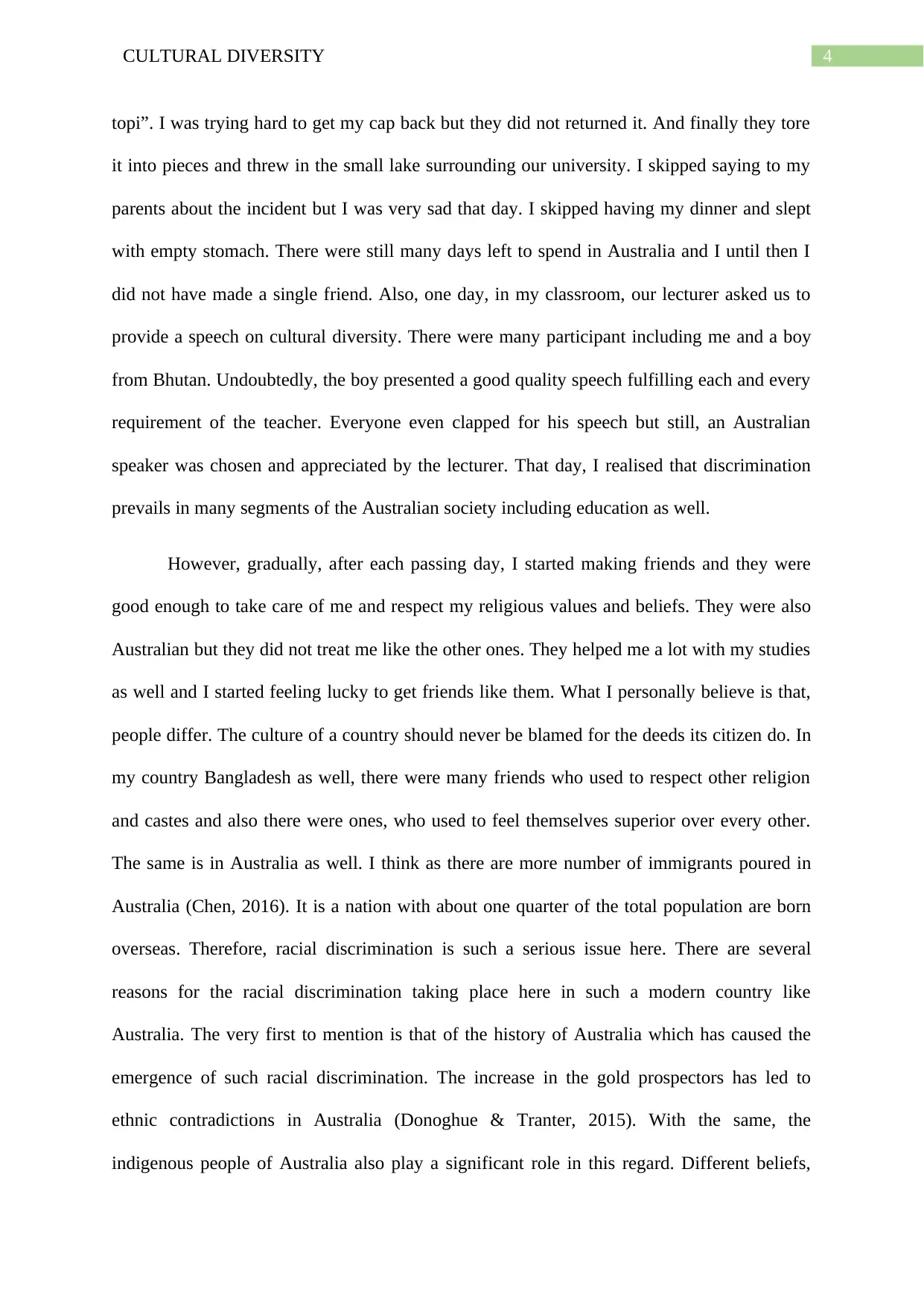
4CULTURAL DIVERSITY
topi”. I was trying hard to get my cap back but they did not returned it. And finally they tore
it into pieces and threw in the small lake surrounding our university. I skipped saying to my
parents about the incident but I was very sad that day. I skipped having my dinner and slept
with empty stomach. There were still many days left to spend in Australia and I until then I
did not have made a single friend. Also, one day, in my classroom, our lecturer asked us to
provide a speech on cultural diversity. There were many participant including me and a boy
from Bhutan. Undoubtedly, the boy presented a good quality speech fulfilling each and every
requirement of the teacher. Everyone even clapped for his speech but still, an Australian
speaker was chosen and appreciated by the lecturer. That day, I realised that discrimination
prevails in many segments of the Australian society including education as well.
However, gradually, after each passing day, I started making friends and they were
good enough to take care of me and respect my religious values and beliefs. They were also
Australian but they did not treat me like the other ones. They helped me a lot with my studies
as well and I started feeling lucky to get friends like them. What I personally believe is that,
people differ. The culture of a country should never be blamed for the deeds its citizen do. In
my country Bangladesh as well, there were many friends who used to respect other religion
and castes and also there were ones, who used to feel themselves superior over every other.
The same is in Australia as well. I think as there are more number of immigrants poured in
Australia (Chen, 2016). It is a nation with about one quarter of the total population are born
overseas. Therefore, racial discrimination is such a serious issue here. There are several
reasons for the racial discrimination taking place here in such a modern country like
Australia. The very first to mention is that of the history of Australia which has caused the
emergence of such racial discrimination. The increase in the gold prospectors has led to
ethnic contradictions in Australia (Donoghue & Tranter, 2015). With the same, the
indigenous people of Australia also play a significant role in this regard. Different beliefs,
topi”. I was trying hard to get my cap back but they did not returned it. And finally they tore
it into pieces and threw in the small lake surrounding our university. I skipped saying to my
parents about the incident but I was very sad that day. I skipped having my dinner and slept
with empty stomach. There were still many days left to spend in Australia and I until then I
did not have made a single friend. Also, one day, in my classroom, our lecturer asked us to
provide a speech on cultural diversity. There were many participant including me and a boy
from Bhutan. Undoubtedly, the boy presented a good quality speech fulfilling each and every
requirement of the teacher. Everyone even clapped for his speech but still, an Australian
speaker was chosen and appreciated by the lecturer. That day, I realised that discrimination
prevails in many segments of the Australian society including education as well.
However, gradually, after each passing day, I started making friends and they were
good enough to take care of me and respect my religious values and beliefs. They were also
Australian but they did not treat me like the other ones. They helped me a lot with my studies
as well and I started feeling lucky to get friends like them. What I personally believe is that,
people differ. The culture of a country should never be blamed for the deeds its citizen do. In
my country Bangladesh as well, there were many friends who used to respect other religion
and castes and also there were ones, who used to feel themselves superior over every other.
The same is in Australia as well. I think as there are more number of immigrants poured in
Australia (Chen, 2016). It is a nation with about one quarter of the total population are born
overseas. Therefore, racial discrimination is such a serious issue here. There are several
reasons for the racial discrimination taking place here in such a modern country like
Australia. The very first to mention is that of the history of Australia which has caused the
emergence of such racial discrimination. The increase in the gold prospectors has led to
ethnic contradictions in Australia (Donoghue & Tranter, 2015). With the same, the
indigenous people of Australia also play a significant role in this regard. Different beliefs,
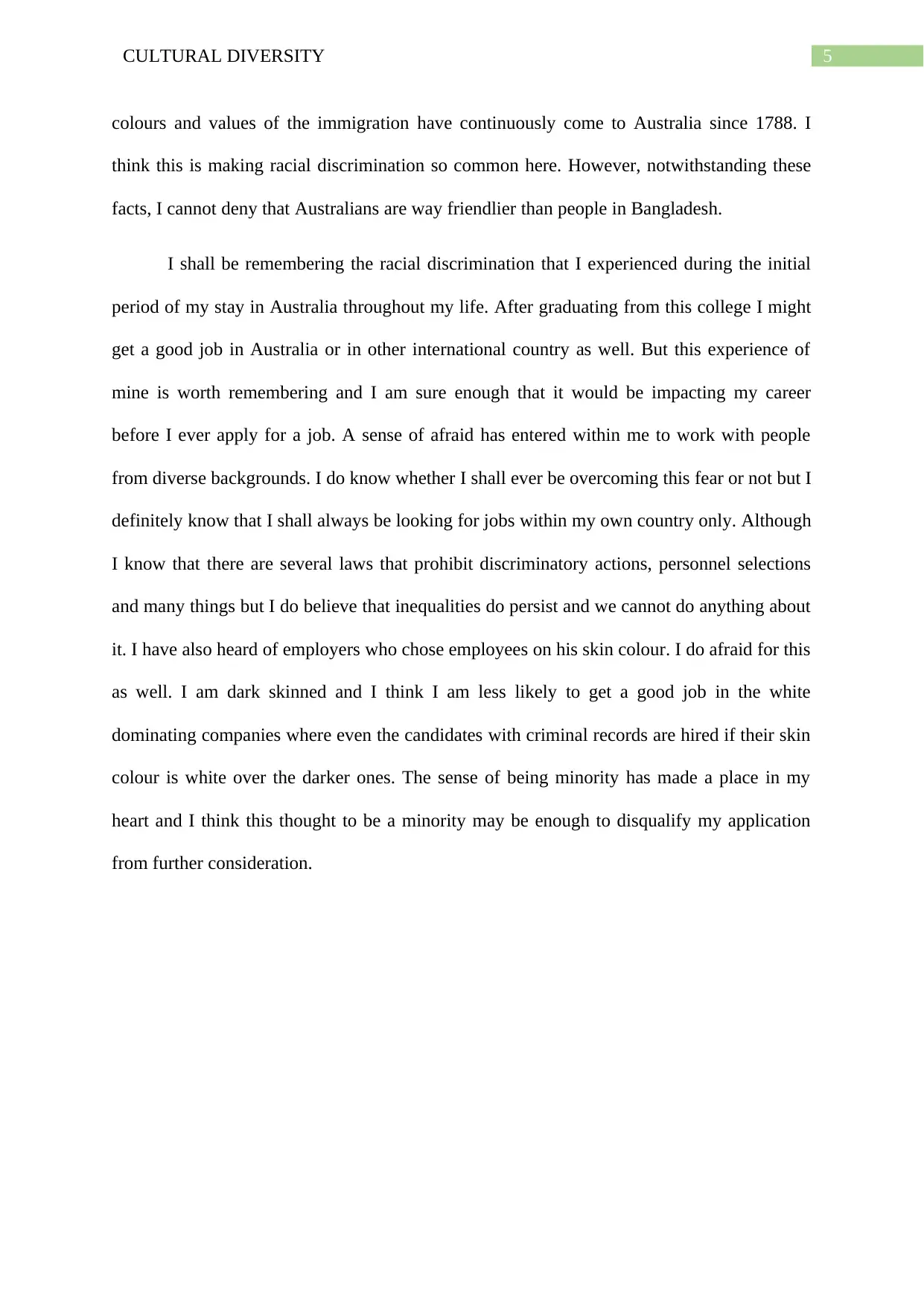
5CULTURAL DIVERSITY
colours and values of the immigration have continuously come to Australia since 1788. I
think this is making racial discrimination so common here. However, notwithstanding these
facts, I cannot deny that Australians are way friendlier than people in Bangladesh.
I shall be remembering the racial discrimination that I experienced during the initial
period of my stay in Australia throughout my life. After graduating from this college I might
get a good job in Australia or in other international country as well. But this experience of
mine is worth remembering and I am sure enough that it would be impacting my career
before I ever apply for a job. A sense of afraid has entered within me to work with people
from diverse backgrounds. I do know whether I shall ever be overcoming this fear or not but I
definitely know that I shall always be looking for jobs within my own country only. Although
I know that there are several laws that prohibit discriminatory actions, personnel selections
and many things but I do believe that inequalities do persist and we cannot do anything about
it. I have also heard of employers who chose employees on his skin colour. I do afraid for this
as well. I am dark skinned and I think I am less likely to get a good job in the white
dominating companies where even the candidates with criminal records are hired if their skin
colour is white over the darker ones. The sense of being minority has made a place in my
heart and I think this thought to be a minority may be enough to disqualify my application
from further consideration.
colours and values of the immigration have continuously come to Australia since 1788. I
think this is making racial discrimination so common here. However, notwithstanding these
facts, I cannot deny that Australians are way friendlier than people in Bangladesh.
I shall be remembering the racial discrimination that I experienced during the initial
period of my stay in Australia throughout my life. After graduating from this college I might
get a good job in Australia or in other international country as well. But this experience of
mine is worth remembering and I am sure enough that it would be impacting my career
before I ever apply for a job. A sense of afraid has entered within me to work with people
from diverse backgrounds. I do know whether I shall ever be overcoming this fear or not but I
definitely know that I shall always be looking for jobs within my own country only. Although
I know that there are several laws that prohibit discriminatory actions, personnel selections
and many things but I do believe that inequalities do persist and we cannot do anything about
it. I have also heard of employers who chose employees on his skin colour. I do afraid for this
as well. I am dark skinned and I think I am less likely to get a good job in the white
dominating companies where even the candidates with criminal records are hired if their skin
colour is white over the darker ones. The sense of being minority has made a place in my
heart and I think this thought to be a minority may be enough to disqualify my application
from further consideration.
⊘ This is a preview!⊘
Do you want full access?
Subscribe today to unlock all pages.

Trusted by 1+ million students worldwide
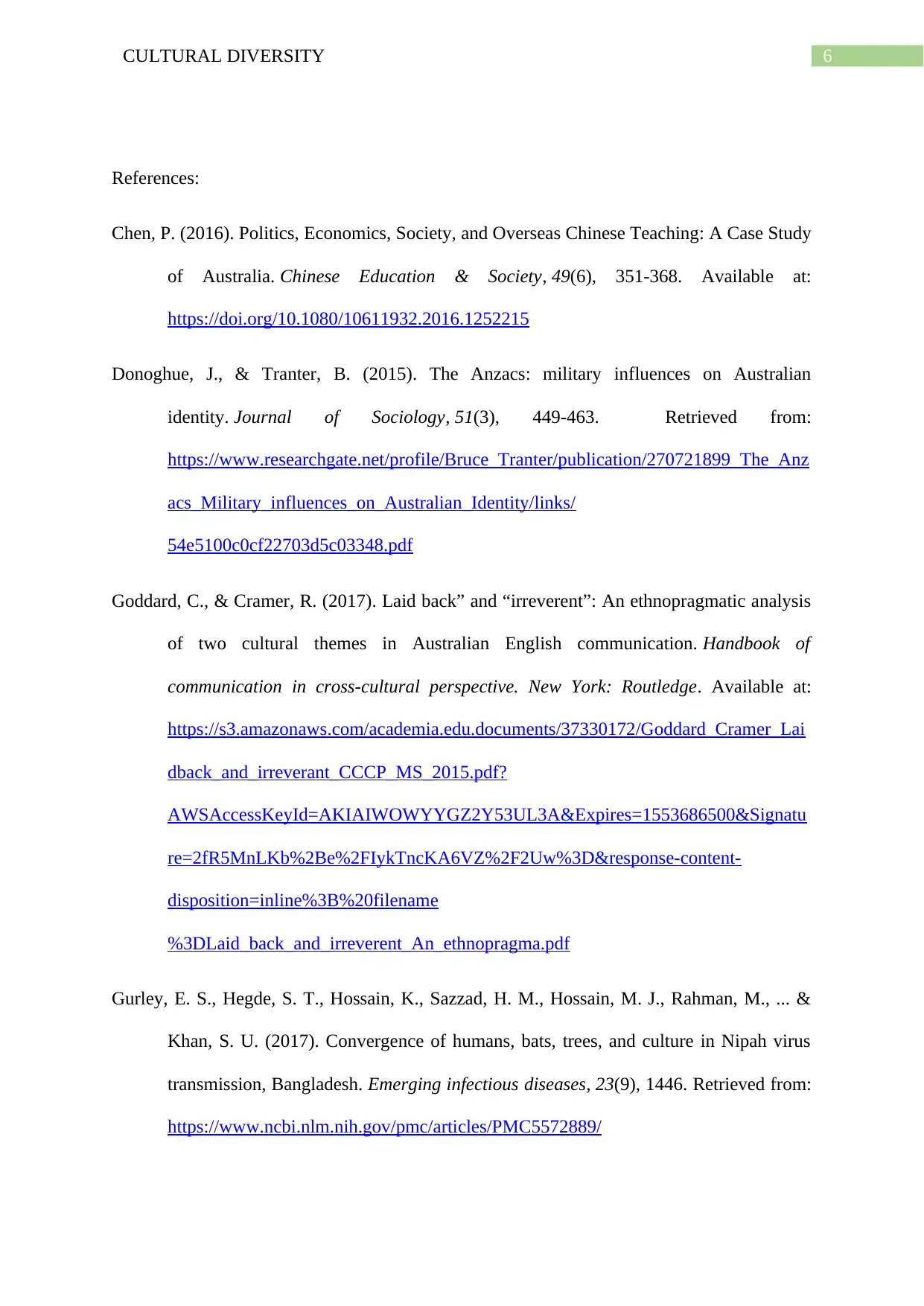
6CULTURAL DIVERSITY
References:
Chen, P. (2016). Politics, Economics, Society, and Overseas Chinese Teaching: A Case Study
of Australia. Chinese Education & Society, 49(6), 351-368. Available at:
https://doi.org/10.1080/10611932.2016.1252215
Donoghue, J., & Tranter, B. (2015). The Anzacs: military influences on Australian
identity. Journal of Sociology, 51(3), 449-463. Retrieved from:
https://www.researchgate.net/profile/Bruce_Tranter/publication/270721899_The_Anz
acs_Military_influences_on_Australian_Identity/links/
54e5100c0cf22703d5c03348.pdf
Goddard, C., & Cramer, R. (2017). Laid back” and “irreverent”: An ethnopragmatic analysis
of two cultural themes in Australian English communication. Handbook of
communication in cross-cultural perspective. New York: Routledge. Available at:
https://s3.amazonaws.com/academia.edu.documents/37330172/Goddard_Cramer_Lai
dback_and_irreverant_CCCP_MS_2015.pdf?
AWSAccessKeyId=AKIAIWOWYYGZ2Y53UL3A&Expires=1553686500&Signatu
re=2fR5MnLKb%2Be%2FIykTncKA6VZ%2F2Uw%3D&response-content-
disposition=inline%3B%20filename
%3DLaid_back_and_irreverent_An_ethnopragma.pdf
Gurley, E. S., Hegde, S. T., Hossain, K., Sazzad, H. M., Hossain, M. J., Rahman, M., ... &
Khan, S. U. (2017). Convergence of humans, bats, trees, and culture in Nipah virus
transmission, Bangladesh. Emerging infectious diseases, 23(9), 1446. Retrieved from:
https://www.ncbi.nlm.nih.gov/pmc/articles/PMC5572889/
References:
Chen, P. (2016). Politics, Economics, Society, and Overseas Chinese Teaching: A Case Study
of Australia. Chinese Education & Society, 49(6), 351-368. Available at:
https://doi.org/10.1080/10611932.2016.1252215
Donoghue, J., & Tranter, B. (2015). The Anzacs: military influences on Australian
identity. Journal of Sociology, 51(3), 449-463. Retrieved from:
https://www.researchgate.net/profile/Bruce_Tranter/publication/270721899_The_Anz
acs_Military_influences_on_Australian_Identity/links/
54e5100c0cf22703d5c03348.pdf
Goddard, C., & Cramer, R. (2017). Laid back” and “irreverent”: An ethnopragmatic analysis
of two cultural themes in Australian English communication. Handbook of
communication in cross-cultural perspective. New York: Routledge. Available at:
https://s3.amazonaws.com/academia.edu.documents/37330172/Goddard_Cramer_Lai
dback_and_irreverant_CCCP_MS_2015.pdf?
AWSAccessKeyId=AKIAIWOWYYGZ2Y53UL3A&Expires=1553686500&Signatu
re=2fR5MnLKb%2Be%2FIykTncKA6VZ%2F2Uw%3D&response-content-
disposition=inline%3B%20filename
%3DLaid_back_and_irreverent_An_ethnopragma.pdf
Gurley, E. S., Hegde, S. T., Hossain, K., Sazzad, H. M., Hossain, M. J., Rahman, M., ... &
Khan, S. U. (2017). Convergence of humans, bats, trees, and culture in Nipah virus
transmission, Bangladesh. Emerging infectious diseases, 23(9), 1446. Retrieved from:
https://www.ncbi.nlm.nih.gov/pmc/articles/PMC5572889/
Paraphrase This Document
Need a fresh take? Get an instant paraphrase of this document with our AI Paraphraser
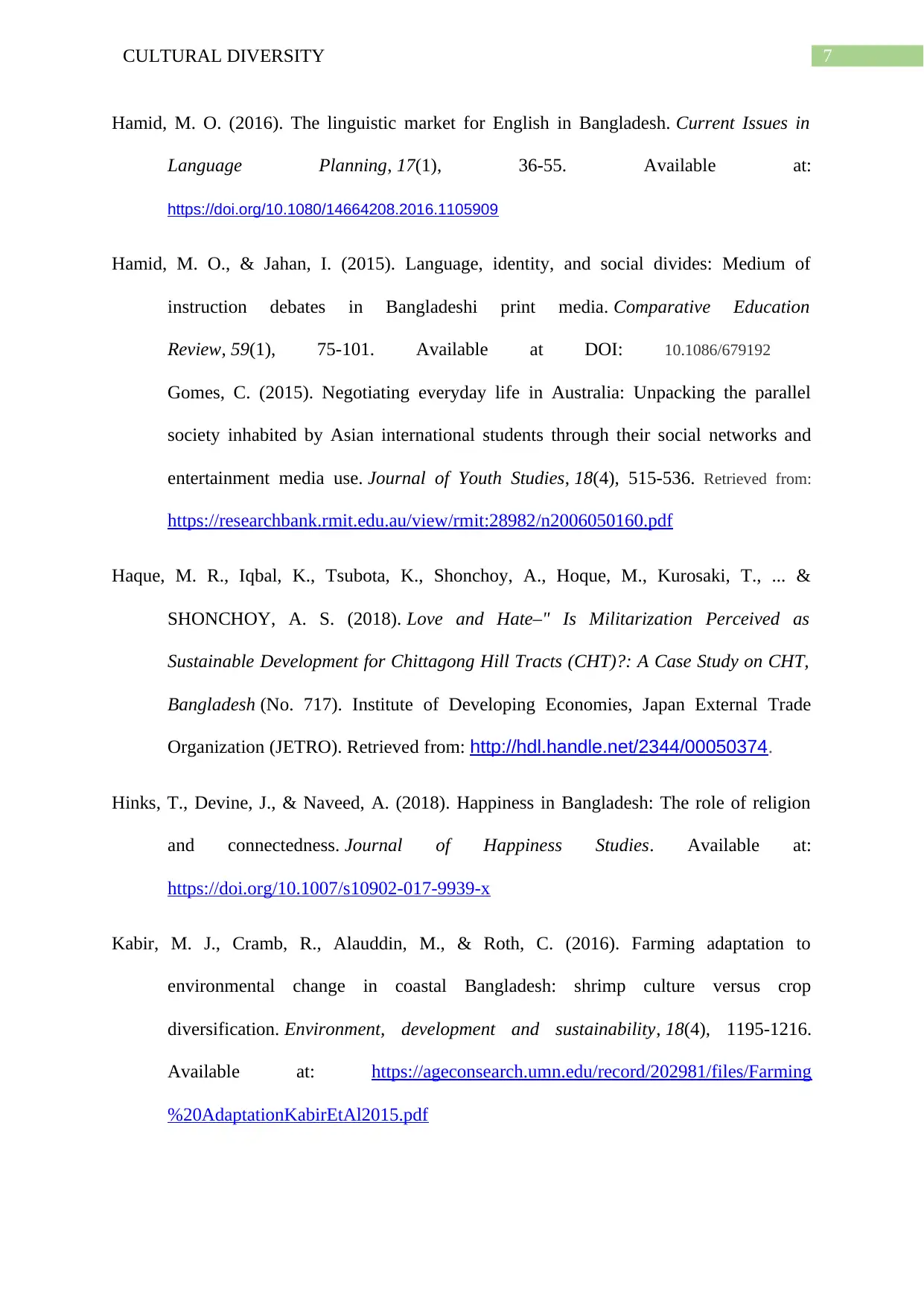
7CULTURAL DIVERSITY
Hamid, M. O. (2016). The linguistic market for English in Bangladesh. Current Issues in
Language Planning, 17(1), 36-55. Available at:
https://doi.org/10.1080/14664208.2016.1105909
Hamid, M. O., & Jahan, I. (2015). Language, identity, and social divides: Medium of
instruction debates in Bangladeshi print media. Comparative Education
Review, 59(1), 75-101. Available at DOI: 10.1086/679192
Gomes, C. (2015). Negotiating everyday life in Australia: Unpacking the parallel
society inhabited by Asian international students through their social networks and
entertainment media use. Journal of Youth Studies, 18(4), 515-536. Retrieved from:
https://researchbank.rmit.edu.au/view/rmit:28982/n2006050160.pdf
Haque, M. R., Iqbal, K., Tsubota, K., Shonchoy, A., Hoque, M., Kurosaki, T., ... &
SHONCHOY, A. S. (2018). Love and Hate–" Is Militarization Perceived as
Sustainable Development for Chittagong Hill Tracts (CHT)?: A Case Study on CHT,
Bangladesh (No. 717). Institute of Developing Economies, Japan External Trade
Organization (JETRO). Retrieved from: http://hdl.handle.net/2344/00050374.
Hinks, T., Devine, J., & Naveed, A. (2018). Happiness in Bangladesh: The role of religion
and connectedness. Journal of Happiness Studies. Available at:
https://doi.org/10.1007/s10902-017-9939-x
Kabir, M. J., Cramb, R., Alauddin, M., & Roth, C. (2016). Farming adaptation to
environmental change in coastal Bangladesh: shrimp culture versus crop
diversification. Environment, development and sustainability, 18(4), 1195-1216.
Available at: https://ageconsearch.umn.edu/record/202981/files/Farming
%20AdaptationKabirEtAl2015.pdf
Hamid, M. O. (2016). The linguistic market for English in Bangladesh. Current Issues in
Language Planning, 17(1), 36-55. Available at:
https://doi.org/10.1080/14664208.2016.1105909
Hamid, M. O., & Jahan, I. (2015). Language, identity, and social divides: Medium of
instruction debates in Bangladeshi print media. Comparative Education
Review, 59(1), 75-101. Available at DOI: 10.1086/679192
Gomes, C. (2015). Negotiating everyday life in Australia: Unpacking the parallel
society inhabited by Asian international students through their social networks and
entertainment media use. Journal of Youth Studies, 18(4), 515-536. Retrieved from:
https://researchbank.rmit.edu.au/view/rmit:28982/n2006050160.pdf
Haque, M. R., Iqbal, K., Tsubota, K., Shonchoy, A., Hoque, M., Kurosaki, T., ... &
SHONCHOY, A. S. (2018). Love and Hate–" Is Militarization Perceived as
Sustainable Development for Chittagong Hill Tracts (CHT)?: A Case Study on CHT,
Bangladesh (No. 717). Institute of Developing Economies, Japan External Trade
Organization (JETRO). Retrieved from: http://hdl.handle.net/2344/00050374.
Hinks, T., Devine, J., & Naveed, A. (2018). Happiness in Bangladesh: The role of religion
and connectedness. Journal of Happiness Studies. Available at:
https://doi.org/10.1007/s10902-017-9939-x
Kabir, M. J., Cramb, R., Alauddin, M., & Roth, C. (2016). Farming adaptation to
environmental change in coastal Bangladesh: shrimp culture versus crop
diversification. Environment, development and sustainability, 18(4), 1195-1216.
Available at: https://ageconsearch.umn.edu/record/202981/files/Farming
%20AdaptationKabirEtAl2015.pdf
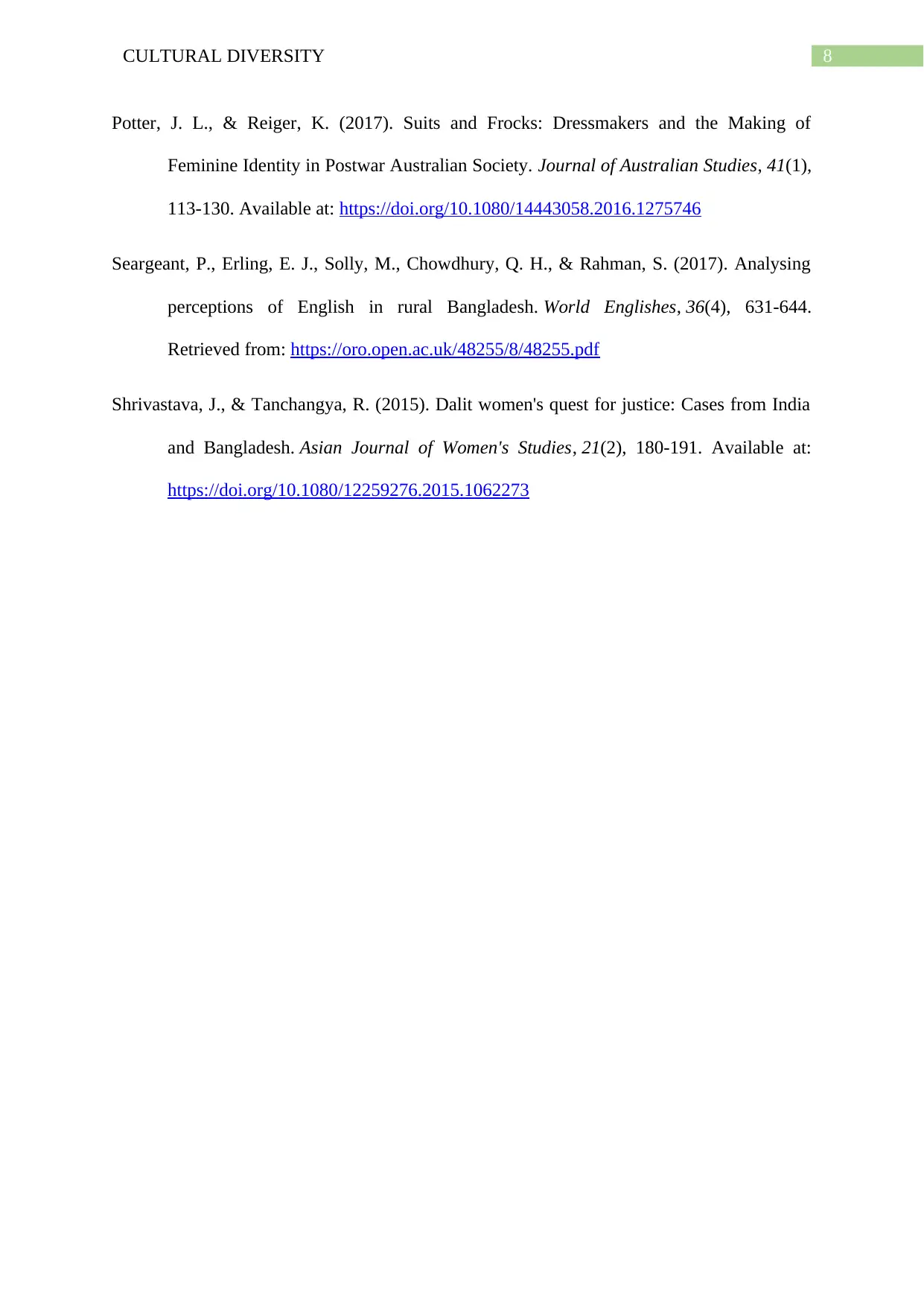
8CULTURAL DIVERSITY
Potter, J. L., & Reiger, K. (2017). Suits and Frocks: Dressmakers and the Making of
Feminine Identity in Postwar Australian Society. Journal of Australian Studies, 41(1),
113-130. Available at: https://doi.org/10.1080/14443058.2016.1275746
Seargeant, P., Erling, E. J., Solly, M., Chowdhury, Q. H., & Rahman, S. (2017). Analysing
perceptions of English in rural Bangladesh. World Englishes, 36(4), 631-644.
Retrieved from: https://oro.open.ac.uk/48255/8/48255.pdf
Shrivastava, J., & Tanchangya, R. (2015). Dalit women's quest for justice: Cases from India
and Bangladesh. Asian Journal of Women's Studies, 21(2), 180-191. Available at:
https://doi.org/10.1080/12259276.2015.1062273
Potter, J. L., & Reiger, K. (2017). Suits and Frocks: Dressmakers and the Making of
Feminine Identity in Postwar Australian Society. Journal of Australian Studies, 41(1),
113-130. Available at: https://doi.org/10.1080/14443058.2016.1275746
Seargeant, P., Erling, E. J., Solly, M., Chowdhury, Q. H., & Rahman, S. (2017). Analysing
perceptions of English in rural Bangladesh. World Englishes, 36(4), 631-644.
Retrieved from: https://oro.open.ac.uk/48255/8/48255.pdf
Shrivastava, J., & Tanchangya, R. (2015). Dalit women's quest for justice: Cases from India
and Bangladesh. Asian Journal of Women's Studies, 21(2), 180-191. Available at:
https://doi.org/10.1080/12259276.2015.1062273
⊘ This is a preview!⊘
Do you want full access?
Subscribe today to unlock all pages.

Trusted by 1+ million students worldwide
1 out of 9
Related Documents
Your All-in-One AI-Powered Toolkit for Academic Success.
+13062052269
info@desklib.com
Available 24*7 on WhatsApp / Email
![[object Object]](/_next/static/media/star-bottom.7253800d.svg)
Unlock your academic potential
Copyright © 2020–2025 A2Z Services. All Rights Reserved. Developed and managed by ZUCOL.





